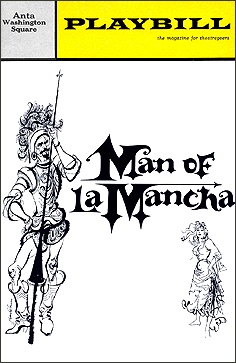
Don Quixote is a Spanish epic novel by Miguel de Cervantes. It was originally published in two parts, in 1605 and 1615. Considered a founding work of Western literature, it is often labelled as the first modern novel and one of the greatest works ever written. Don Quixote is also one of the most-translated books in the world and one of the best-selling novels of all time.

Die Entführung aus dem Serail is a singspiel in three acts by Wolfgang Amadeus Mozart. The German libretto is by Gottlieb Stephanie, based on Christoph Friedrich Bretzner's Belmont und Constanze, oder Die Entführung aus dem Serail. The plot concerns the attempt of the hero Belmonte, assisted by his servant Pedrillo, to rescue his beloved Constanze from the seraglio of Pasha Selim. The work premiered on 16 July 1782 at the Vienna Burgtheater, with the composer conducting.

Man of La Mancha is a 1965 musical with a book by Dale Wasserman, music by Mitch Leigh, and lyrics by Joe Darion. It is adapted from Wasserman's non-musical 1959 teleplay I, Don Quixote, which was in turn inspired by Miguel de Cervantes and his 17th-century novel Don Quixote. It tells the story of the "mad" knight Don Quixote as a play within a play, performed by Cervantes and his fellow prisoners as he awaits a hearing with the Spanish Inquisition. The work is not and does not pretend to be a faithful rendition of either Cervantes' life or Don Quixote. Wasserman complained repeatedly about people taking the work as a musical version of Don Quixote.

Dulcinea del Toboso is a fictional character who is unseen in Miguel de Cervantes' novel Don Quijote. Don Quijote believes he must have a lady, under the mistaken view that chivalry requires it. As he does not have one, he invents her, making her the very model of female perfection: "[h]er name is Dulcinea, her country El Toboso, a village of La Mancha, her rank must be at least that of a princess, since she is my queen and lady, and her beauty superhuman, since all the impossible and fanciful attributes of beauty which the poets apply to their ladies are verified in her; for her hairs are gold, her forehead Elysian fields, her eyebrows rainbows, her eyes suns, her cheeks roses, her lips coral, her teeth pearls, her neck alabaster, her bosom marble, her hands ivory, her fairness snow, and what modesty conceals from sight such, I think and imagine, as rational reflection can only extol, not compare".

Sancho Panza is a fictional character in the novel Don Quixote written by Spanish author Miguel de Cervantes Saavedra in 1605. Sancho acts as squire to Don Quixote and provides comments throughout the novel, known as sanchismos, that are a combination of broad humour, ironic Spanish proverbs, and earthy wit. "Panza" in Spanish means "belly".

Don Quichotte is an opera in five acts by Jules Massenet to a French libretto by Henri Caïn. It was first performed on 19 February 1910 at the Opéra de Monte-Carlo.
Don Quixote, fully El ingenioso hidalgo Don Quijote de la Mancha, is a classic novel by Miguel de Cervantes Saavedra, originally published in two parts, in 1605 and 1615.
Don Quichotte chez la Duchesse is a "comic ballet" by the French baroque composer Joseph Bodin de Boismortier. Although it is described as a ballet, it is sung throughout with a libretto by Charles Simon Favart.

Die Hochzeit des Camacho is a Singspiel in two acts by Felix Mendelssohn, to a libretto probably written largely by Friedrich Voigts, based on an episode in Don Quixote by Cervantes. The opera is listed as Mendelssohn's op. 10. It was written between 1824 and 1825, and first performed publicly at the Berlin Schauspielhaus on 29 April 1827.

Don Quixote, Op. 50 is an opera in three acts by Wilhelm Kienzl. The libretto, written by the composer, is based on the novel by Miguel de Cervantes.
Johann Sigismund Kusser or Cousser was a composer born in the Kingdom of Hungary who was active in Germany, France, and Ireland.

Der Tod Jesu is an oratorio libretto by Karl Wilhelm Ramler. In its setting by Carl Heinrich Graun in 1755, it was the most often performed Passion of the 18th century in Germany.
Michael Schneider is a German flautist, recorder player, conductor and academic teacher. He is especially connected with later Baroque repertoire such as the works of Telemann and with early Classical repertoire such as the works of Carl Philipp Emanuel Bach, and founded the orchestra La Stagione to perform and record such repertoire.

Der geduldige Socrates is a comic German-language opera in three acts by Georg Philipp Telemann to a libretto by Johann Ulrich von König.

Joseph Aloys Schmittbaur was a German composer, Kapellmeister, instrument maker and music teacher.
Daniel Schiebeler was a German writer, poet, librettist and Protestant hymnwriter. He wrote librettos for operas and oratorios, set by composers such as Georg Philipp Telemann, Johann Adam Hiller and Carl Philipp Emanuel Bach.

Don Chisciotte alle nozze di Gamace, composed by Antonio Salieri, is an Italian-language opera. The libretto presents the opera as in one act, and the musical score includes a mid-point division, both score, and libretto originally denoted the work a divertimento treatrale. The libretto was written by Giovanni Gastone Boccherini, dancer, poet and stage manager, brother of the composer Luigi Boccherini. The work is loosely adapted from chapters 19 and 21 of Part II of the novel Don Quixote by Miguel de Cervantes. The work was a hybrid opera buffa and ballet, with choreography by Jean-Georges Noverre.
Johann Peter Ritter was a German composer, conductor, chorus master, and cellist born and died in Mannheim, Karlsruhe, Baden-Württemberg, Germany). He is best known in the United States for "Sun of My Soul" and "Holy God, We Praise Thy Name."
L'Orfeo Barockorchester is an Austrian Ensemble of historically informed performance.












